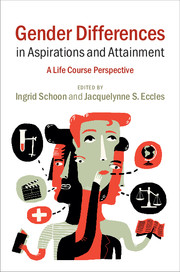Book contents
- Frontmatter
- Contents
- List of Figures
- List of Tables
- Notes on Contributors
- List of Abbreviations (selected)
- Part I Introduction
- Part II The early school years
- Part III Career planning during adolescence
- Part IV Choosing a science career
- Part V Longer-term consequences of early experiences
- 16 The life course consequences of single-sex and co-educational schooling
- 17 Pathways to educational attainment in middle adulthood
- 18 How gender influences objective career success and subjective career satisfaction
- Part VI The role of context
- Index
- References
17 - Pathways to educational attainment in middle adulthood
The role of gender and parental educational expectations in adolescence
Published online by Cambridge University Press: 05 October 2014
- Frontmatter
- Contents
- List of Figures
- List of Tables
- Notes on Contributors
- List of Abbreviations (selected)
- Part I Introduction
- Part II The early school years
- Part III Career planning during adolescence
- Part IV Choosing a science career
- Part V Longer-term consequences of early experiences
- 16 The life course consequences of single-sex and co-educational schooling
- 17 Pathways to educational attainment in middle adulthood
- 18 How gender influences objective career success and subjective career satisfaction
- Part VI The role of context
- Index
- References
Summary
Abstract
In this chapter, we apply the expectancy-value model of motivation, particularly the family socialization aspect of the model (Eccles (Parsons) et al., 1983; Eccles, 1994, 2007; Wigfield & Eccles, 2002) to address a number of key questions regarding gender differences in adult attainment, in particular educational attainment. When some individuals in the work force of today were children, what kinds of expectations did they have for themselves? What expectations did their parents have for them? Did these expectations vary for girls and boys? Were parents’ expectations about their children’s future education related to the actual education that these adolescents later attained in midlife? How did the child’s academic ability and characteristics of the family figure into this picture? We present original empirical findings, drawing on data collected for a Swedish longitudinal study that spans from childhood to middle adulthood. In line with the expectancy-value model of motivation, the family’s socioeconomic status (SES) was identified as an important predictor of several outcomes. Consistent with the model, for both genders, the family’s SES and parental educational expectations in middle adolescence predicted middle adult educational attainment. The importance of grades differed by gender in that the mathematics grade was a statistically significant predictor of middle adult educational attainment for males, while for females grades in Swedish were a statistically significant predictor of middle adult educational attainment. In this chapter, we situated these study findings in the wider pertinent scholarly literature and discussed the implications of our results as they might relate to efforts to promote equitable and optimal life chances for the current generation of European girls and boys.
Information
- Type
- Chapter
- Information
- Gender Differences in Aspirations and AttainmentA Life Course Perspective, pp. 389 - 411Publisher: Cambridge University PressPrint publication year: 2014
References
Accessibility standard: Unknown
Why this information is here
This section outlines the accessibility features of this content - including support for screen readers, full keyboard navigation and high-contrast display options. This may not be relevant for you.Accessibility Information
- 1
- Cited by
